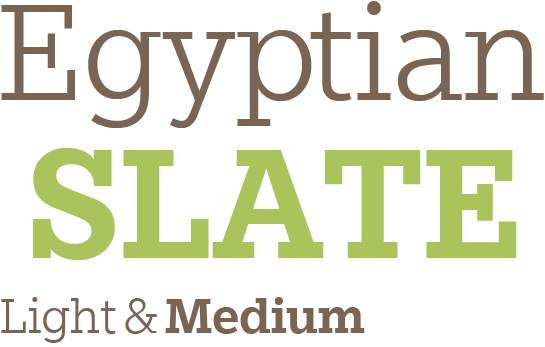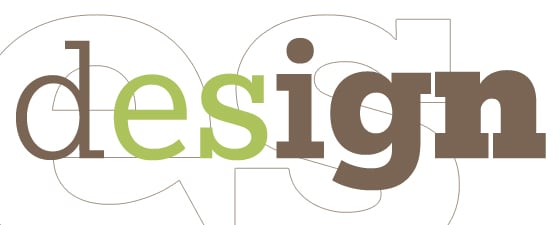Egyptian Slate
A solid, stylish slab serif design:
the new Egyptian Slate from Rod McDonald
Just as the camera adds weight to human faces, serifs can add weight to typographic faces. Rod McDonald trimmed and adjusted his new Egyptian Slate™ design as it emerged from its sans serif predecessor, the Slate™ design. The result is a solid and stylish slab serif design that will look superb in the spotlight of your choosing.
 Rod McDonald had the first sketches for the Egyptian Slate typeface design in the works even before the original sans serif branch of the family had been released. He recalls, “I was considering the addition of a serif complement to the sans serif designs from the get-go. After a number of trials incorporating different serif styles, it became readily apparent that a slab serif version would be the best route to take.”
Rod McDonald had the first sketches for the Egyptian Slate typeface design in the works even before the original sans serif branch of the family had been released. He recalls, “I was considering the addition of a serif complement to the sans serif designs from the get-go. After a number of trials incorporating different serif styles, it became readily apparent that a slab serif version would be the best route to take.”
 McDonald soon discovered that the openness of the letterforms in the Slate design allowed him to add the strong slab serifs without losing any of the character of the original design. “I was surprised that Egyptian Slate held its own with Slate,” recalls McDonald, “but I was also stunned when I realized that it was going to be a lot more work to add the serifs than I initially thought. Incorporating serifs into a sans serif design throws all the weights off.” To maintain visual parity between the two designs, McDonald had to change the basic weights of the new slab serif design. Adjustments were needed on every character to compensate for the added visual weight of the serifs.
McDonald soon discovered that the openness of the letterforms in the Slate design allowed him to add the strong slab serifs without losing any of the character of the original design. “I was surprised that Egyptian Slate held its own with Slate,” recalls McDonald, “but I was also stunned when I realized that it was going to be a lot more work to add the serifs than I initially thought. Incorporating serifs into a sans serif design throws all the weights off.” To maintain visual parity between the two designs, McDonald had to change the basic weights of the new slab serif design. Adjustments were needed on every character to compensate for the added visual weight of the serifs.McDonald drew the roman designs; he then collaborated with Carl Crossgrove to create the italic counterparts. McDonald provided the foundational “control characters,” and Crossgrove built on these to produce the finished designs. “I had worked with Carl previously when he developed the condensed range for Slate,” says McDonald, “so I knew that the Egyptian Slate italics were in good hands.”
 The name Egyptian Slate came about in a rather unexpected way. From the beginning McDonald had trouble coming up with an appropriate name. He tried several, but none stuck. But when McDonald was in the final stages of the design, Robert Bringhurst – author of the acclaimed Elements of Typographic Style – happened to be visiting. On one occasion, McDonald was muttering about “slabs of Slate” and generally complaining about not being able to find the right name for this new typeface. Without missing a beat, Bringhurst offered, “Why don’t you call it Egyptian Slate”? This apt name stuck.
The name Egyptian Slate came about in a rather unexpected way. From the beginning McDonald had trouble coming up with an appropriate name. He tried several, but none stuck. But when McDonald was in the final stages of the design, Robert Bringhurst – author of the acclaimed Elements of Typographic Style – happened to be visiting. On one occasion, McDonald was muttering about “slabs of Slate” and generally complaining about not being able to find the right name for this new typeface. Without missing a beat, Bringhurst offered, “Why don’t you call it Egyptian Slate”? This apt name stuck.The Egyptian Slate family is available in six weights – from a svelte light to a commanding black – each with a complementary italic. The family is also available as OpenType Pro fonts which offer an extended character set that supports most Central European and many Eastern European languages.